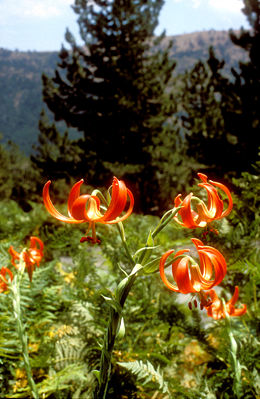Chalcedonian lily
| Chalcedonian lily | ||||||||||||
|---|---|---|---|---|---|---|---|---|---|---|---|---|

Chalcedonian lily ( Lilium chalcedonicum ) |
||||||||||||
| Systematics | ||||||||||||
|
||||||||||||
| Scientific name | ||||||||||||
| Lilium chalcedonicum | ||||||||||||
| L. |

The chalcedony lily ( Lilium chalcedonicum ) is a species from the genus of lilies ( Lilium ) in the Liriotypus section (Candidum section) .
description
The chalcedony lily is a perennial herbaceous plant that usually reaches heights of 35 to 70 centimeters. The onion is white-yellowish and broad. From spring onwards, the plant forms a stem densely covered with narrow, lanceolate leaves that become shorter towards the top . The scattered foliage is almost horizontal at the base, but more and more upright towards the upper end, until the leaves are almost on the stem.
In July to August a panicle appears on it with one to four (rarely up to twelve) strongly recurved, vermilion flowers, which are strongly papilous at the base . The pollen is deep red-orange. The seed germinates with a delay - epigeous .
The number of chromosomes is 2n = 24.
distribution
The Chalcedonian Lily is only native to southern Albania , Greece and the Ionian Islands . It thrives in slightly moist, partially shaded locations in open deciduous forests, boxwood bushes and meadows on calcareous, rocky subsoil between 600 and 1700 meters altitude.
Systematics
The Chalcedonian lily was first described by Carl von Linné in 1753. At times, in addition to the nominate form, the varieties Lilium chalcedonicum var. Maculatum (with a dense black-dotted flower) and Lilium chalcedonicum var. Heldreichii (hairless on the upper part of the stem) were listed. However, they are both no longer recognized today.
Lilium chalcedonicum can form the natural hybrid Lilium x testaceum with the Madonna lily ( Lilium candidum ) .
Culture
The oldest known depiction of a lily probably shows Chalcedonian lilies. These are around 3500 year old frescoes in the Bronze Age city of Akrotiri on the Greek island of Santorini , which was buried by a volcano during the Minoan eruption .
Because of its spectacular appearance, it has been cultivated since at least the 16th century. It is said to have been brought to Europe from Constantinople by Master Harbran in 1597 .
Individual evidence
- ↑ a b c d e Arne Strid: The lilies of Greece. In: Caroline Boisset (Ed.): Lilies And Related Plants , 2007, pp. 18-26, ISBN 978-1-902896-84-7
- ↑ a b c d e Carl Feldmaier, Judith McRae: Lilien. Ulmer, Stuttgart 1982, ISBN 3-8001-6121-4
- ^ Tropicos. [1]
- ↑ Thera Foundation: Spring Fresco ( Memento from April 25, 2012 in the Internet Archive ) - Description and interpretation of the spring frescoes in Akrotiri (English)